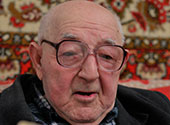
Yosl Kogan was born in 1927 in Bershad. His father, a soap-maker, died during the 1933 famine. He was brought up by his mother, a candy-maker. He spent much of the war in the Bershad ghetto, where he wrote songs about his experiences. He served in the Red Army and participated in the liberation of Berlin. After his military service, he worked at a liquor factory in Bershad, draining molasses. He moved to Tulchyn in 1960 and worked in a procurement office.
Other Interviews:
"I love Yiddish"Valik, Zhuzhia and Ivanov
"And every day we waited to die"
Tsezeyt un tseshpreyt (Scattered and dispersed)
Aheym, briderlekh, aheym (Homeward, brother, homeward)
From the Chimney to Berlin
Inside the Ghetto
Tulchyn, Ukraine
Yosl Kogan sung us several songs he had written about the Bershad ghetto. One of these is a sardonic satire of the well-known Soviet song, “Zhankoye,” an upbeat propaganda piece about Jews building farms and new lives for themselves in the collective farms of Crimea. The original song begins with the famous lines: “As you travel to Sevastopol / Not too far from Simferopol /There’s a railroad station” and continues to celebrate how former shtetl Jews with typical shtetl names—Abrasha, Leye, Beyle—are now working on collective farms as productive Soviet workers, as reapers, threshers, and tractor drivers. Kogan took the basic melody of "Zhankoye,” but sung it at a slower, more somber pace, and altered the lyrics to deride the optimistic life promised by the original song. Rather than the open fields of the Crimean countryside, Kogan situated his song in the overcrowded Bershad ghetto, which he calls a camp.
Avrom-Iche fort af dem vognEs iz a kharpe im tsu zognEr makht shoyn skhakl shoyn dem zektsn tur.Di obshchine hot im geheysnIm farnemen ale meysimGroyen im far veytik azh di hor.Oy-vey, tsores, tsoresToygn yidn af kaporesHoft men afn mazldikn tog.Inem shtetl, Bershad, der besoylemPrinimayet yenem oylemGriber shtaygn poshet nit farshit.Es lign yidn un zey foylnAzh dos harts heybt on tsu groyen Akh farvos darf opkumen der yid.Oy-vey, tsores, tsoresToygn yidn af kaporesHoft men afn mazldikn tog.
Instead of the railroad station found at the end of the road in the original song, Kogan finds a concentration camp. Instead of Abrasha, whose tractor races through the field, Kogan inserts Avrom-Itshe, who hauls a wagon full of corpses. Leye the reaper is replaced with Dvoyre who snores, and Beyle the thresher becomes Reb Gedalya, who holds the Torah. Each of the characters in Kogan’s song is based on a real individual he knew from the ghetto: Avrom-Itshe Lekhetser, he told us, “was given a wagon with a horse. He would collect the corpses six times a day—no less. They were falling like flies.” Gedalya, he continued, “was one of our shoykhets,” and Dvoyre was his wife. When the Germans came through the town on their retreat in 1944, Kogan explained, they executed Gedalya on charges that he had been assisting the partisans in the forests outside the town. Kogan honored the murdered Gedalya as the one who “holds the Torah and pleads to God for a miracle.” Source: Jeffrey Veidlinger, In the Shadow of the Shtetl: Small-Town Jewish Life in Soviet Ukraine (Indiana University Press, 2013)
